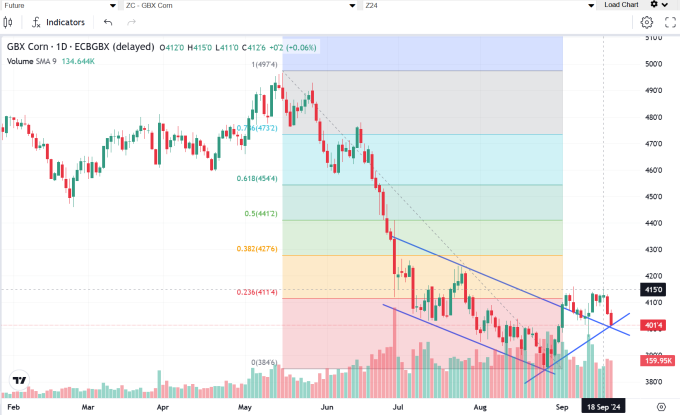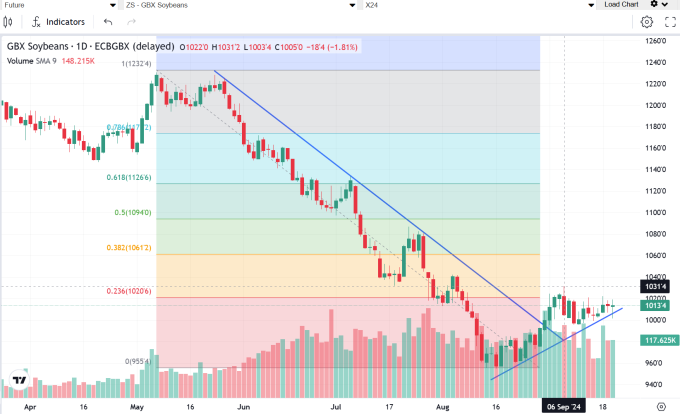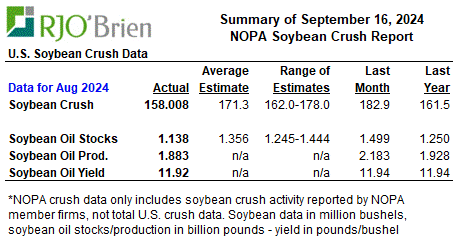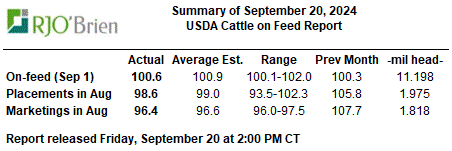Howdy market watchers!
This Sunday marks the official end to summer and the start of the autumn season. I’ll bet I’m not alone in welcoming this transition of summer heat to our rearview mirror. In fact, it was the hottest August on record in the US with temps above 100 degrees Fahrenheit in the southern Plains all the way to Saturday, the final day of summer.
The good news is that the change is almost immediate with next week’s highs in the 80s with more chances of crucial precipitation that have been severely lacking.
Cattlemen in hopes of winter wheat pasture have been dusting in the crop with more hope than certainty. I was also one of those late this week to get seed in the ground in hopes of weekend rains.
The low-pressure system across western Kansas brought needed moisture that also stalled the wheat rally, but helped add premium to the cattle market. Parts of Oklahoma also received showers, but it was extremely spotty.
The US drought monitor continues to add deeper shades of color that indicate worsening drought conditions. This is really impacting basis bids for row crop farmers in the Midwest where low water levels along the Mississippi river system limit the ability of elevators to ship out surplus as harvest progresses and space gets filled up. With a larger corn and soybean crop expected, basis bids are at risk of reducing even further if water levels continue to limit barge traffic and raise the cost of outbound freight. However, that could translate to stability in futures as farmers are less likely to sell if basis and futures prices continue to weaken.

Having said that, grain delivered to 3rd party elevators versus stored on-farm will incur storage costs in addition to interest to hold grain unpriced. With the US corn harvest now 9 percent complete, ahead of last year and well ahead of average, but behind expectations, we could see some harvest pressure ahead for corn and soybean futures.
December corn futures did their darndest to hold above $4.00 on Friday. With global corn crop issues emerging in the Ukraine, EU and UK, perhaps the larger US crop potential is already factored in to these price level and we stay above this psychological $4.00 handle.

In the soybean complex, we’re watching demand for US beans and weather in Brazil. China continues to buy US soybeans this week after a few days silent due to the Mid-Autumn Festival holidays. In fact, US bean exports last week were the largest since November 2023 and China’s imports of US beans were 70 percent higher than last year. While that is welcome news for demand, keep in mind that there is a lot of catch-up buying emerging now that prices have dropped.
Weather models are beginning to lean wetter for northern Brazil next month and this will be a closely watched development in the coming weeks. US soybean harvest is underway and ahead of schedule at 6 percent complete. It will be interesting to see how hot, dry conditions in August impact final yield numbers with many fields in southern states not worth harvesting. Of course, this is limited volume in the broader picture, but there will be some yield impacts in select areas.
November beans managed to close positive on Friday just above $10.13, right at the 50-day moving average, with the day’s lows finding support at the 20-day moving average. The chart action has continued to coil up with Thursdays inside day followed by Friday’s outside day likely to lead to a break-out, in either direction, next week.

The August NOPA data released this week weighed on demand optimism with US soybean crush coming in significantly lower than expected at 7-year lows. Soybean oil stocks, however, were also significantly lower than expected at 20-year same-month lows and could turn supportive if demand picks back with depleted stock levels.

The corn charts finished the week with Friday’s close at the day’s lows at $4.01 ½. While we’re still above $4.00, that was a disappointing close that was also below the crossover of the 20-day and 50-day moving averages around $4.04. The close was however right along an upward sloping trendline connecting recent lows that will need to hold next week. Trade below the September 12th $3.97 low could mark a reversal of the recent uptrend.
The biggest news this week that has the potential to support commodities generally was the Fed’s FOMC decision to lower interest rates by 50 basis points, or 0.50 percent. This is the first time in four years that interest rates are being cut after ratcheting up by 500 basis points, or 5 percent, to fight higher inflation following COVID fiscal stimulus and subsequent government spending to stimulate the economy. This was seen as a material move with many expecting 25 basis points and described by Fed Chair Powell as a “recalibration” of monetary policy as inflation declines and the job market softens.
This is especially welcome news for individuals and small businesses and the real estate market. These “savings” on floating interest rate loans help to lessen borrowing costs immediately and should help to add needed relief to spenders.
Despite choppy trade, the major equity indices again made new highs to close out the week. The US dollar made a new low on announcement of the cut as I forecast in last week’s article, but managed to stabilize through the end of the week.
For commodities to realize a broader benefit, I’d like to see the US dollar index close below the 100.00 level and start trading at a lower band.

I sure had high hopes for the wheat market after the cut and weakening US dollar index, but Kansas rains and weaker exports dominated. Attacks on Ukraine’s Port of Odesa provided partial support, but quickly faded. The only piece of good news is that milling wheat and Chicago wheat futures did not make new, daily lows on Friday. Kansas City wheat did make a new low however but clawed back into the close on Friday right at Thursday’s low.
The wheat complex needs to bounce out of here if there’s hope of more upside soon.
Black Sea tensions and lower crop estimates this week out of the EU and fewer wheat acres expected in Ukraine this next season should provide some renewed buying interest in this market. Middle East tensions are only getting more heated and could see area importers secure additional stocks that would boost demand. We need a trigger to buffer against increasing rain chances in the southern Plains next week to hold these levels. US winter wheat is now 14 percent complete that is just ahead of the average.

On the Russian front, President Putin announced this week about increasing the size of the army for the third time since 2022, which would bring the overall size to exceed that of the US and India and second largest to China. These developments could be that trigger leading up to the US Presidential election, now just 45 days away.
The USDA’s Cattle-on-Feed report was released at 2 PM on Friday, after the market close at 1:05 PM. Overall, it was a fairly neutral report with numbers coming in very near average trade guesses. Total on-feed numbers as of September 1st were 100.6 percent of last year while 100.9 percent were expected. August placements were 98.6 percent of last year versus 99.0 percent expected while other expectations showed 98.5 percent. Marketings in August were 96.4 percent versus 96.6 percent expected.

If I had to pick a side, I would say this report leaned slightly bullish with lower on-feed and placement numbers. The strength of consumer spending is however a cloud hanging over the market.
The livestock complex had an impressive showing this week across feeder and fed cattle as well as hogs. All feeder contracts in 2024 reached their 50-day moving averages above $240. The 2025 contracts are still lagging, but cross the mid-230s and could reach their 50-day moving averages, some $4-5 per cwt higher, next week if the equity rally remains intact.
Fed cattle cash trade developed late week topping out at $184 in Nebraska and Colorado. December Live cattle futures reached and faced resistance Friday at the 100-day ($183.00) and 200-day ($183.45) moving averages and may need higher cash trade to extend above these levels. The 2025 contracts have another $2 and $3 to reach these key moving averages after bouncing off the 50-day moving average on Friday.

Impressive performance that was helped by lower interest rates helping build confidence. However, interest rates are cut when the environment looks weaker and so we need to be vigilant that we don’t let the over-used “Goldilocks” euphoria get us too complacent at protecting these price levels on our physical cattle price exposure.
Sidwell Strategies offers all your risk management tools in one place and so join the Sidwell Team today! Sidwell Strategies is the one-stop shop to protect cattle with futures, puts, LRP or a combination of all, which is probably the best strategy overall.
If you’re ready to trade commodity markets, give me a call at (580) 232-2272 or stop by my office to get your account set up and discuss risk management and marketing solutions to pursue your objectives. Self-trading accounts are also available. It is never too late to start and there is no operation too small to get a risk management and marketing plan in place.
Wishing everyone a successful trading week! Let us know if you'd like to join our daily market price and commentary text messages to stay informed!
Brady Sidwell is a Series 3 Licensed Commodity Futures Broker and Principal of Sidwell Strategies. He can be reached at (580) 232-2272 or at brady@sidwellstrategies.com. Futures and Options trading involves the risk of loss and may not be suitable for all investors. Review full disclaimer at http://www.sidwellstrategies.com/disclaimer.
On the date of publication, Brady Sidwell did not have (either directly or indirectly) positions in any of the securities mentioned in this article. All information and data in this article is solely for informational purposes. For more information please view the Disclosure Policy here.
Disclaimer: The copyright of this article belongs to the original author. Reposting this article is solely for the purpose of information dissemination and does not constitute any investment advice. If there is any infringement, please contact us immediately. We will make corrections or deletions as necessary. Thank you.







